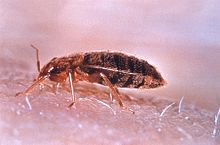Systematics of bedbugs











The taxonomic classification within the bugs was traditionally based on the shape of the antennae . Pierre André Latreille distinguished two groups according to this feature in 1825, which he named after the way of life Hydrocorisae (water bugs) and Geocorisae (land bugs); the Hydrocorisae correspond to today's suborder Nepomorpha ( water bugs ). In 1833, Léon Dufour separated the Amphibicorisae (water striders) from the Geocorisae, today's suborder Gerromorpha . In 1861 Franz Xaver Fieber introduced the different names Cryptocerata, with hidden antennae, for the Hydrocorisae and Gymnocerata, with antennae that are free and visible from above, for the Geocorisae. Since the work of Leston, Pendergrast and Southwood (1954) and the other authors mentioned, one differentiates between seven partial orders within the bedbugs. Schuh & Slater (1995) also followed this subdivision. The monophyly of all seven was finally confirmed in a multigene study in 2012 based on molecular phylogeny. According to this, the combination of the two partial orders Gerromorpha and Dipsocoromorpha , as suggested alternatively by some authors, is not justified.
The following system of bedbugs is carried out down to the family level and is based on Schuh & Slater (1995), supplemented by the more recent work by Henry (1997) on the Pentatomomorpha and Grazia, Schuh & Wheeler (2008) on the Pentatomoidea and is supplemented by the superfamilies according to Foottit & Adler (2009)
- Partial order Enicocephalomorpha
- Family Aenictopecheidae
- Family Enicocephalidae
- Partial order Dipsocoromorpha
- Family Ceratocombidae
- Family Dipsocoridae
- Schizopteridae family
- Family Hypsipterygidae
- Family Stemmocryptidae
- Partial order Gerromorpha (water strider iw S.)
- Superfamily Gerroidea
- Water strider family (Gerridae)
- Family Hermatobatidae
- Family Bach runners (Veliidae)
- Superfamily Hebroidea
- Family velvet water bug (Hebridae)
- Macroveliidae family
- Family Paraphrynoveliidae
- Superfamily Hydrometroidea
- Family hydrometridae (Hydrometridae)
- Superfamily Mesoveloidea
- Family sandpiper (Mesoveliidae)
- Superfamily Gerroidea
- Partial order water bugs (Nepomorpha)
- Superfamily Corixoidea
- Family row bugs or water leaf hoppers (Corixidae)
- Superfamily Naucoroidea
- Family ground bugs (Aphelocheiridae)
- Family Potamocoridae
- Family swimming bugs (Naucoridae)
- Superfamily Nepoidea
- Giant bug family (Belostomatidae)
- Family scorpion bugs or scorpion bugs (Nepidae)
- Superfamily Notonectoidea
- Backstroke family (Notonectidae)
- Family dwarf swimmers (Pleidae)
- Family Helotrephidae
- Superfamily Ochteroidea
- Family Gelastocoridae
- Family Ochteridae
- Superfamily Corixoidea
- Partial order Leptopodomorpha
- Superfamily Leptopodoidea
- Family Leptopodidae
- Family Omaniidae
- Superfamily Saldoidea
- Family Aepophilidae
- Family bank bugs or spring bugs (Saldidae)
- Superfamily Leptopodoidea
- Partial order Cimicomorpha
- Superfamily Cimicoidea
- Flower bug family (Anthocoridae)
- Flat bugs family (Cimicidae)
- Family Lasiochilidae
- Family Lyctocoridae
- Family Plokiophilidae
- Family Polyctenidae
- Superfamily Joppeicoidea
- Family Joppeicidae
- Superfamily Microphysoidea
- Family microphysidae (Microphysidae)
- Superfamily Miroidea
- Soft bug family (Miridae)
- Family Thaumastocoridae
- Family net bugs or lattice bugs (Tingidae)
- Superfamily Naboidea
- Family Medocostidae
- Sickle bug family (Nabidae)
- Superfamily Reduvioidea
- Family Pachynomidae
- Family bugs (Reduviidae)
- Superfamily Velocipedoidea
- Family Curaliidae
- Family Velocipedidae
- Superfamily Cimicoidea
- Partial order Pentatomomorpha (stink bugs iw S.)
- Superfamily Aradoidea
- Family bark bugs (Aradidae)
- Termitaphididae family
- Superfamily Coreoidea
- Family crooked bugs (Alydidae)
- Family border bugs or leather bugs (Coreidae)
- Glass wing bug family (Rhopalidae)
- Family Hyocephalidae
- Family Stenocephalidae
- Superfamily Idiostoloidea
- Family Henicocoridae
- Family Idiostolidae
- Superfamily Lygaeoidea
- Family Artheneidae
- Family stilt bugs (Berytidae)
- Lean bugs family (Blissidae)
- Family Colobathristidae
- Family Cryptorhamphidae
- Family Cymidae
- Family Geocoridae
- Family Heterogastridae
- Family ground bugs or long bugs (Lygaeidae)
- Malcidae family
- Ninidae family
- Family Oxycarenidae
- Family Pachygronthidae
- Family bug bugs (Piesmatidae)
- Family Rhyparochromidae
- Superfamily Pentatomoidea
- Family spiny bugs or belly bugs (Acanthosomatidae)
- Canopidae family
- Family earth bugs (Cydnidae)
- Corimelaenidae family
- Family Dinidoridae
- Family Lestoniidae
- Family Megarididae
- Stink bug family (Pentatomidae)
- Family Phloeidae
- Ball bug family (Plataspididae)
- Family tortoiseshell (Scutelleridae)
- Family Tessaratomidae
- Family Thaumastellidae
- Family Urostylididae
- Family Saileriolidae
- Superfamily Pyrrhocoridea
- Superfamily Aradoidea
supporting documents
Individual evidence
- ^ Dennis Leston , JG Pendergrast & Richard Southwood : Classification of the terrestrial Heteroptera (Geocorisae). Nature 174, 1954, 91.
- ↑ a b R.T. Schuh, JA Slater: True Bugs of the World (Hemiptera: Heteroptera). Classification and Natural History. Cornell University Press, Ithaca, New York, 1995.
- ↑ Min Li, Ying Tian, Ying Zhao, Wenjun Bu (2012): Higher Level Phylogeny and the First Divergence Time Estimation of Heteroptera (Insecta: Hemiptera) Based on Multiple Genes. PLoS ONE 7 (2): e32152. doi : 10.1371 / journal.pone.0032152 (open access)
- ^ TJ Henry: Phylogenetic analysis of family groups within the infraorder Pentatomomorpha (Hemiptera: Heteroptera), with emphasis on the Lygaeoidea. Annals of the Entomological Society of America 90 (3): 275-301, 1997.
- ↑ Jocelia Grazia, Randall T. Schuh & Ward C. Wheeler: Phylogenetic relationships of family groups in Pentatomoidea based on morphology and DNA sequences (Insecta: Heteroptera). Cladistics 24 (2008), pp. 932-976.
- ↑ Robert G. Foottit, Peter H. Adler: Insect Biodiversity: Science and Society . Wiley-Blackwell, New York 2009, ISBN 978-1-4051-5142-9 .
